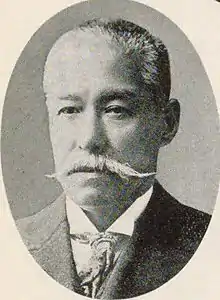Hotta Masayasu (Viscount)
Viscount Hotta Masayasu (堀田正養, 1 April 1848 – 9 May 1911) was the 9th and final daimyō of Ōmi-Miyagawa Domain under the Tokugawa shogunate, and served as a politician and cabinet minister in the post-Meiji Restoration Empire of Japan.[1]
Hotta Masayasu | |
|---|---|
| 堀田正養 | |
 Hotta Masayasu, post-Meiji restoration | |
| In office 1864–1868 | |
| Monarchs | Shōgun |
| Preceded by | Hotta Masami |
| Succeeded by | < position abolished > |
| Imperial Governor of Miyagawa | |
| In office 1869–1871 | |
| Monarch | Emperor Meiji |
| 17th Minister of Communications | |
| In office 25 March 1908 – 19 July 1908 | |
| Monarch | Emperor Meiji |
| Preceded by | Hara Takashi |
| Succeeded by | Gotō Shinpei |
| Personal details | |
| Born | April 1, 1848 Yurihonjō, Akita, Japan |
| Died | May 9, 1911 (aged 63) |
| Spouse | daughter of Hotta Masami |
| Parent |
|
Biography
Hotta Masayasu was born as the 9th son of Iwaki Takahiro, the daimyō of Kameda Domain in Dewa Province. He was married to a daughter of Hotta Masami, the daimyō of Ōmi-Miyagawa Domain and upon Hotta Masami's death, he was posthumously adopted on 4 July 1863 to carry on the Hotta family name as daimyō of the 13,000 koku domain. He was received in formal audience by Shōgun Tokugawa Iemochi on 21 July, and was given the courtesy title of Buzen-no-kami and lower 5th court rank on 26 November. In July 1864, he was assigned the post of Osaka Kaban. Following the Boshin War on 16 February 1868, the new Meiji government abolished Miyagawa Domain and assigned its territory to neighboring Hikone Domain and temporarily placed him under house arrest. However, on 23 June 1869, Hotta was returned to his former holdings as imperial governor, retaining that position until the abolition of the han system in 1871. In September 1871, he relocated to Tokyo.[1]
In December 1878, Hotta was elected to a seat in the Tokyo Prefectural Assembly from Asasuka Ward (now part of Taitō, Tokyo), becoming Chairman of the Assembly in March 1879. In January 1880, he became head of Akasaka Ward (now part of Minato, Tokyo) and in June 1881, he became head of Shitaya Ward (now part of Taitō, Tokyo) followed by Fukawaga Ward (now part of Kōtō, Tokyo) in August of the same year. In July 1884, he was awarded the kazoku peerage title of shishaku (viscount). He was president of the Chikuhō Railway (筑豊鉄道, Chikuhō Tetsudō), a local railway line which operated in Fukuoka prefecture from 1891 to 1897.[1]
In July 1890, Hotta became a member of the House of Peers in the new Diet of Japan. On 25 March 1908 he joined the 1st Saionji administration as Minister of Communications, but was forced to resign with the collapse of the Saionji administration in July of the same year.[1]
References
- Asahi Shinbun, eds (1994). 朝日 日本歴史人物事典. Asahi Shinbun. ISBN 4023400521.
{{cite book}}:|last1=has generic name (help)